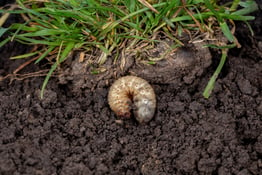I hear the statement that “use this pre-emergent to prevent the weed seeds from germinating” This is a false statement, because our turfgrass pre-emergents do not work unless the weed seeds have germinated. Weed seeds can lay dormant in the soil for years until the conditions are correct for them to germinate. If the initial statement was true, you should be able to apply a pre-emergent and kill all of the seeds that are in the soil. These chemicals are called pre-emergents not pre-germinators. So, if they do not prevent the seeds from germinating how do they work?
Soil Temperature. NOT Air Temperature.
Annual grassy weeds both annuals and perennials germinate at different times and under different environmental conditions. The three main annual grassy weeds that are prominent in turfgrass in the Spring are; crabgrass, foxtail, and goosegrass. There are others, and these main three also may have different varieties within each species that may develop slightly differently. Other grassy weeds like Poa annua germinate in the fall.
- Crabgrass needs a soil temperature of 55°F for about 5 days to start the germination process -
Of these three, crabgrass is the first to germinate followed by foxtail and then goosegrass. Crabgrass needs a soil temperature of 55°F for about 5 days to start the germination process. Soil moisture needs to be adequate, and for crabgrass sunlight is necessary. Foxtail germinates next at slightly warmer soil temps, still needs the soil moisture, but will germinate in shade as well as open sun. Goosegrass germinates about a month later, due to warmer soil temps are needed, but also does not require sunlight to germinate.
People like to use flowering plants to go by to determine when to have their pre-emergent down. This idea can give you a general time frame, but flower bud development is governed by air temperature and not soil temperature.
You WANT weed seeds to germinate
- Dithiopyr 2L, is capable of providing limited post-emergent control of crabgrass until the 2-3 leaf stage -
So, if pre-emergents do not prevent weed seeds from germinating, how to they prevent grasses and some broadleaf weeds from invading our turf? To be correct, you want the weed seeds to germinate. Once a seed germinates, the initial or primary root emerges from the seed. At this point, if a pre-emergent has been applied, when the young root absorbs moisture from the soil, the pre-emergent does its job. Depending on the specific active that is contained in the pre-emergent, either the root or initial leaf is prevents from developing and that plant dies. All of this activity occurs below the turf canopy and is never seen. This is probably the reason that people state that the seeds are prevented from germinating. One pre-emergent, Dithiopyr 2L, is capable of providing limited post-emergent control of crabgrass until the 2-3 leaf stage. This still mostly occurs unseen by the turf manager. Pre-emergents are chemicals that are highly un-soluble. This is important because you want the active to remain at or very near the soil surface because this is where the majority of the weeds are and germinate. To make a proper application, you should have the pre-emergent applied 1-2 weeks before the weed seed germinates. This allows time for the pre-emergent to form a barrier across the soil surface. It is better to go early vs. late when applying your pre-emergent. Pre-emergents are mainly broken down by soil microbes. These micros are also controlled by soil temperature. If the soil temperature is cold, no microbe activity occurs and the chemical sits in the soil unaffected. With that said, going earlier not later is a good policy to follow.
